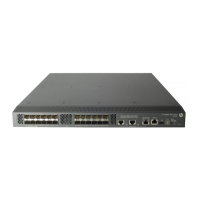7
• If you press Tab after you enter the keyword of an alias, the original format of the keyword is displayed.
• Replace only the first keyword of a non-undo command instead of the complete command; and replace
only the second keyword of undo commands.
To configure command aliases:
Ste
Command
Remarks
1. Enter system view.
system-view —
2. Enable the command alias
function.
command-alias enable
Required
Disabled by default, which means you
cannot configure command aliases.
3. Configure a command alias.
command-alias mapping
cmdkey alias
Required
Not configured by default.
Configuring CLI hotkeys
Ste
Command
Remarks
1. Enter system view. system-view —
2. Configure CLI
hotkeys.
hotkey { CTRL_G |
CTRL_L | CTRL_O |
CTRL_T | CTRL_U }
command
Optional
By default, the Ctrl+G, Ctrl+L and Ctrl+O hotkeys
are associated with pre-defined commands and
the Ctrl+T and Ctrl+U hotkeys are not.
•
Ctrl+G corresponds to display
current-configuration.
• Ctrl+L corresponds to display ip routing-table.
• Ctrl+O corresponds to undo debugging all.
3. Display hotkeys. display hotkey
Available in any view.
See Table 3 for hotkeys reserved by the system.
Table 3 Hotkeys reserved by the system
The hotkeys in this table above are defined by the switch. If the same hotkeys are defined by the terminal
software you use to interact with the switch, the hotkeys defined by the terminal software take effect.
Hotke
Function
Ctrl+A Moves the cursor to the beginning of the current line.
Ctrl+B Moves the cursor one character to the left.
Ctrl+C Stops performing a command.
Ctrl+D Deletes the character at the current cursor position.
Ctrl+E Moves the cursor to the end of the current line.
Ctrl+F Moves the cursor one character to the right.
Ctrl+H Deletes the character to the left of the cursor.
Ctrl+K Terminates an outgoing connection.
Ctrl+N Displays the next command in the history command buffer.

